BEE AUG 2021
Northern Baja California (part 2)
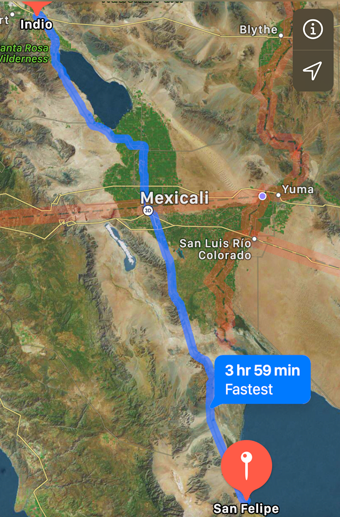 This month´s entry continues from where we ended last month in the San Felipe Desert, not far south of San Felipe.
This month´s entry continues from where we ended last month in the San Felipe Desert, not far south of San Felipe.
Signs of Spring were evident in the patches of wildflowers that popped up every now and then at roadside or in the sandy soils adjacent to the highway. And the more we looked the more we found.
Fuente: OpenStreetMap 2021
Carretera 5 - Km 17 north of San Felipe — April 2021
This spot was near a side road, easy to pull onto from the highway was it passed through the rear of the coastal dunes and a sandy plain. Lots of side roads lead to housing developments on the coast here.
The dominant plants along this stretch an beyond San Felipe are Creosotebush (Larrea tridentata, Zygophyllaceae), Mexican-Tea (Ephedra trifurca, Ephedraceae), Catclaw Acacia (Senegalia greggii, Fabaceae), and Bursage (Ambrosia dumosa, Asteraceae). The Desert Ironwood (Olneya tesota, Fabaceae) and occasional Torotes (Pachycormus discolor var. pubescens, Anacardiaceae) that we had seen along here last year in full bloom were not (yet) evident as we passed by.
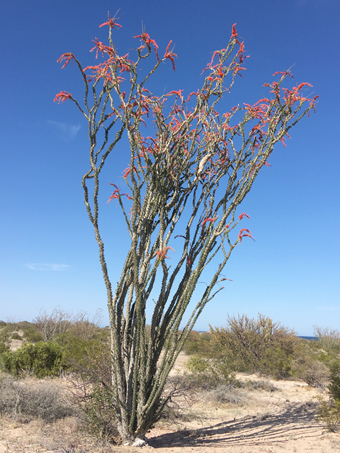
Ocotillo (Fouquieria splendens, Fouquieriaceae).
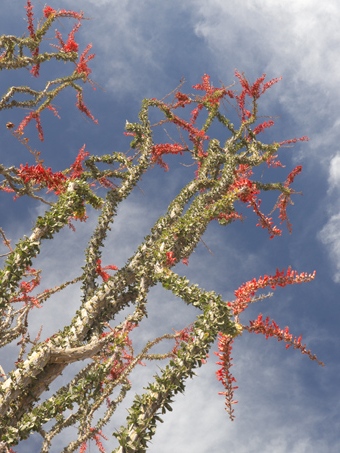
Ocotillo (Fouquieria splendens).
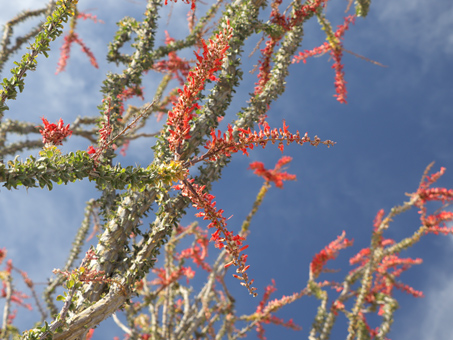
Ocotillo (Fouquieria splendens).
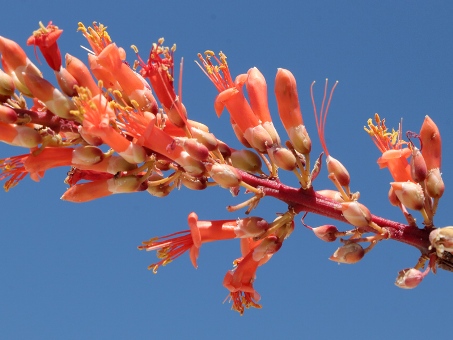
Ocotillo (Fouquieria splendens).
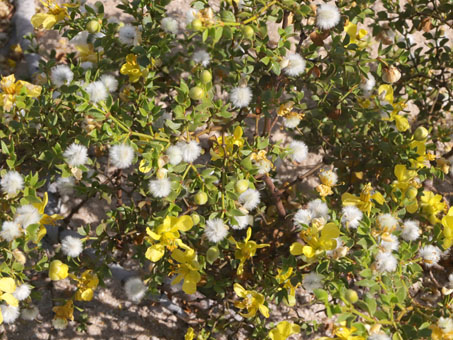
Creosotebush (Larrea tridentata, Zygophyllaceae) full of flowers and fruit.
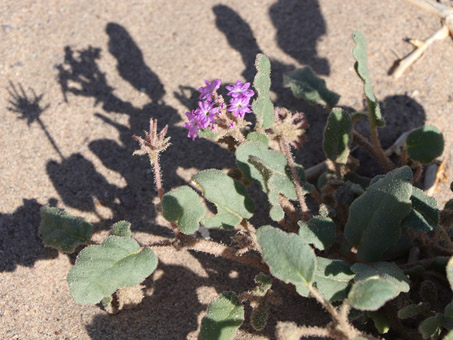
Sand Verbena (Abronia sp.). There were some dense patches of this over a several kilometers.
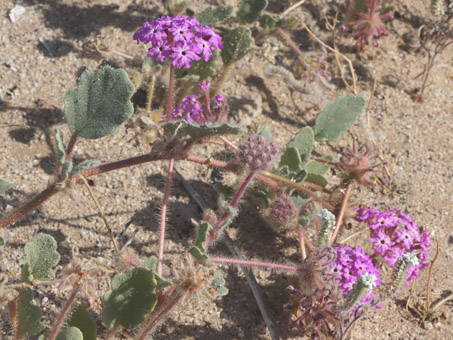
Sand Verbena. Either Abronia gracilis or A. villosa. Since I didn't key it at the time, I'm not able to be definitive. Both may occur here.
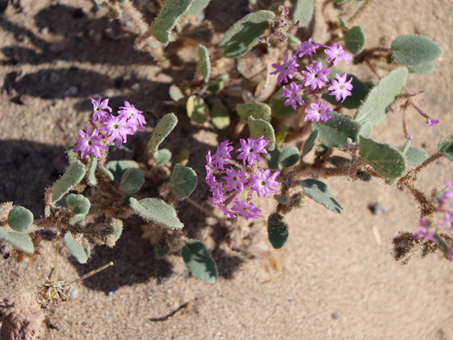
Desert Sand Verbena species are annual plants with a prostrate to decumbent habit and thickened leaves.
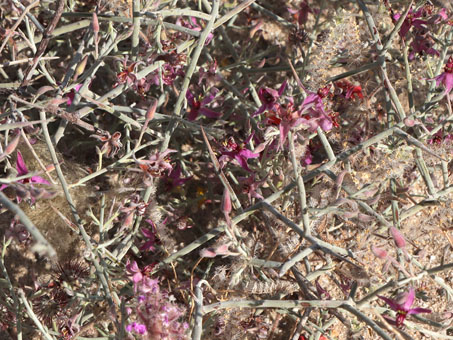
White Ratany (Krameria bicolor, Krameriaceae), a native shrub, occurs along the eastern side of the peninsula, south to about Loreto. The gray-green branches and linear leaves are finely but densely hairy.
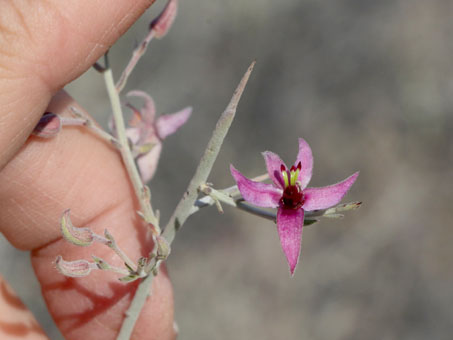
White Ratany has five colorful, petaloid sepals. Three fused petals can be seen above, yellow with pink tips. The other two below are fused and modified to form an oil gland that is visited by oil bees.
Hwy 5 - Km 3-4 South of San Felipe
We stopped in this same area last year in January on our way back to Mulegé from Los Algodones. Some of the species we saw at that time were dormant or dead (annuals) and I had to guess what they might be on the small amount of information they provided as to their identity. I had been driving and had decided after the previous stop that I was really done botanizing for the day. But when we got to this point, what I saw along several kilometers changed my mind and I looked for the first chance to pull over.
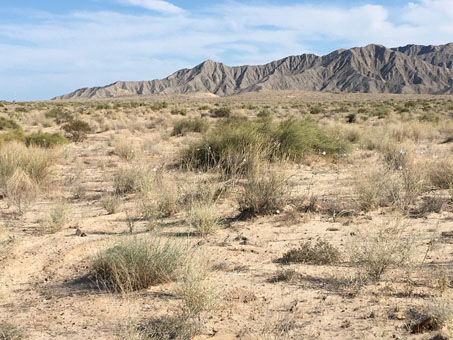
What isn't very visible in this image are the hundreds of white blooms of an unfamiliar species. They certainly weren't prickly poppies, though they were leggy like them.
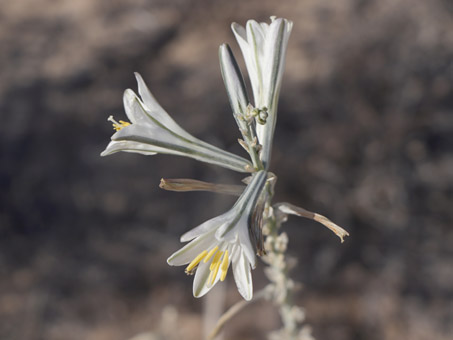
Once out of the car and up close, we discovered that we were seeing Desert Lily / Ajo Silvestre (Hesperocallis undulata, Agavaceae), a native species growing from a deeply buried bulb. They were everywhere.
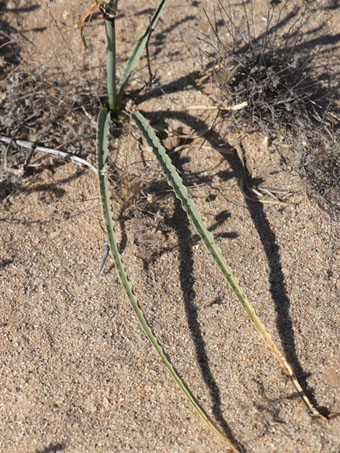
Desert lily is native to the Sonoran & Mojave deserts. The strappy leaves have wavy margins. Most of the plants we saw were about 1 m tall, though it can apparently reach almost twice that.
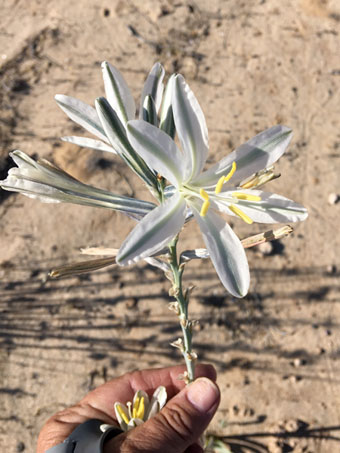
The 4.5 to 6 cm D funnelform flowers are jointed to the pedicel. The six perianth parts are white with a gray-green midstripe on the inferior surface.
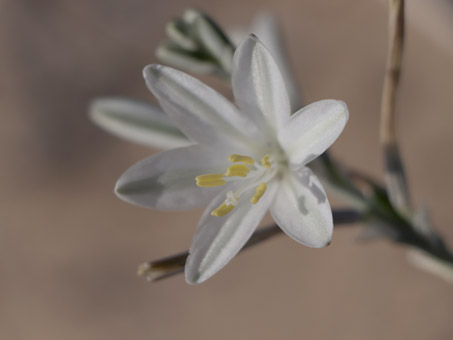
Desert Lily (Hesperocallis undulata, Agavaceae).
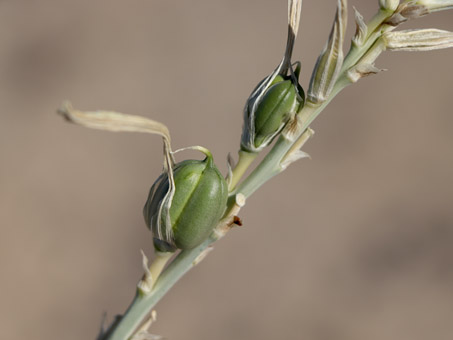
The fruit of Desert Lily is a 3-lobed capsule c. 1-1.5 cm L that splits open longitudinally at maturity. Seeds are many, flat, 2-3 mm D & black.
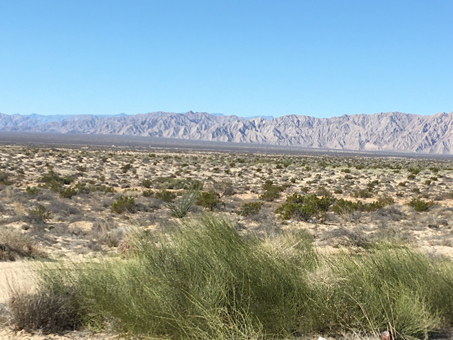
Three-Fork Ephedra or Mexican-Tea / Cañatillo (Ephedra trifurca). It is also visible in the first photo from this location (large green mounds). Fairly rare in BC, mainly found in ne BC in creosote scrub and sand dunes such as these.
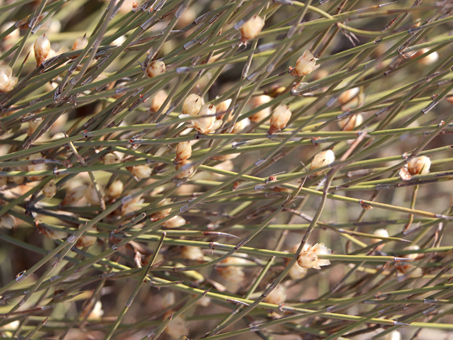
Ephedra trifurca stems and cones. Young stems are yellowish green but age to tan or gray and end in sharp, spine-like points. Leaf sheaths are membranous & gray.
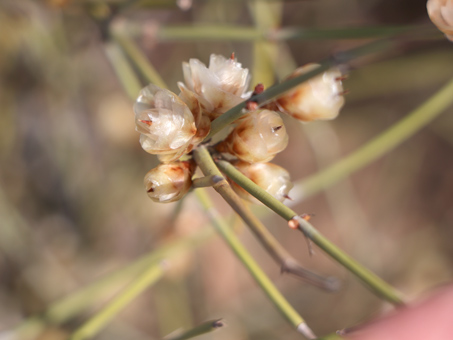
Male pollen and female seed cones of Ephedra trifurca are present on separate plants. These are seed cones.
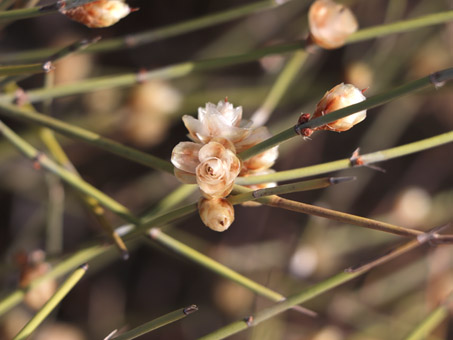
Ephedra trifurca seed cones, with the pointy tip of the seeds visible in the center among the papery bracts.
Hwy 5 - Km 86-87 North of San Felipe, dunes near La Ventana
The dune field here is located on the northern western flanks of the Sierra las Pintas which rise above the Salinas de Omtepec in the Upper Gulf of California. Winds from the NW drive sand from Laguna Salada located many kilometers away to here, where it builds up at the base of the small mountain range.

We just stopped here for a rest but were pleasantly surprised by lots of tiny plants.
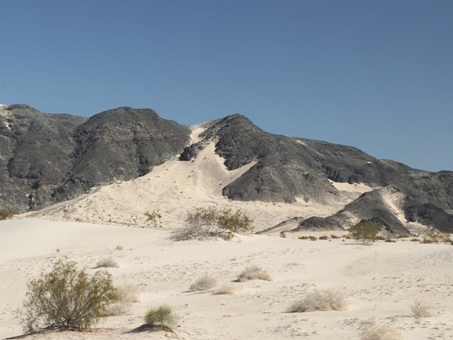
The sparse vegetation here consisted primarily of Creosotebush (Larrea tridentata), Mexican-tea (Ephedra trifurca) and Slender-leaf Saltbush (Atriplex linearis, Chenopodiaceae). But there were many tiny annuals.
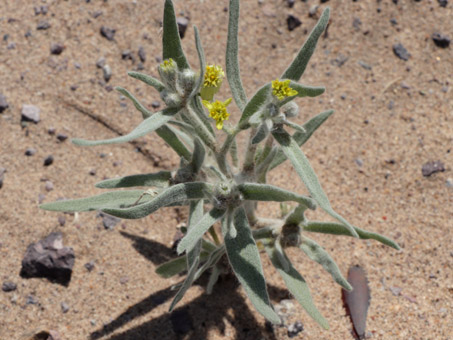
Colorado or Short-Ray Desert-Marigold (Baileya pauciradiata, Asteraceae) is an annual herb, here about 20 cm H.
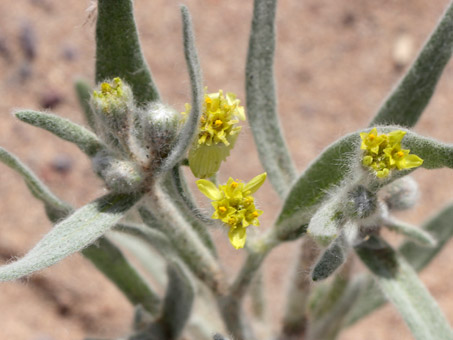
Short-ray Desert-Marigold is densely hairy, making it perfectly adapted to life on a hot, arid dune.
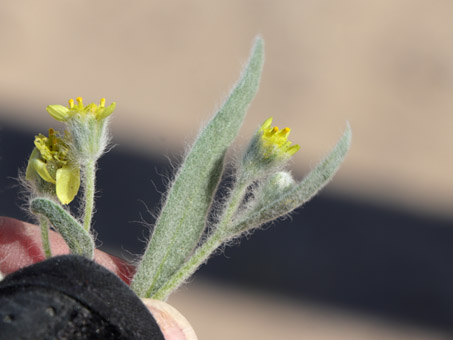
The capitula of Short-Ray Desert-Marigold (Baileya pauciradiata) are c. 4-6 mm D and 8-10 mm L with 4-8 ray flowers and 8-20 disk flowers.
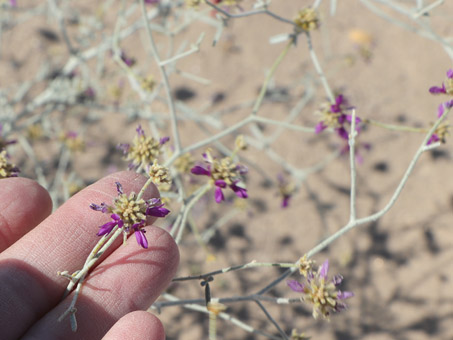
Emory Dye Bush (Psorothamnus emoryi var. emoryi, Fabaceae) is also well adapted to dune life, with silvery, densely hairy stems in an open, intricate growth habit. More about this species.
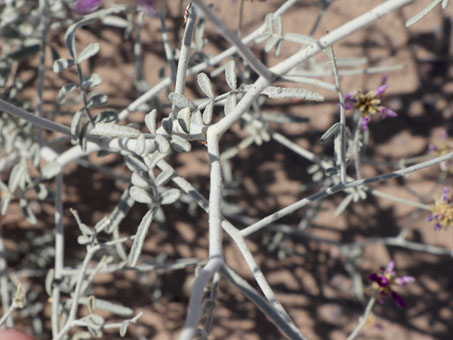
The leaves and stems of Emory Dye Bush have small, orange, strongly scented oil glands on their surface that likely deter herbivores. More leaves and glands here and here.
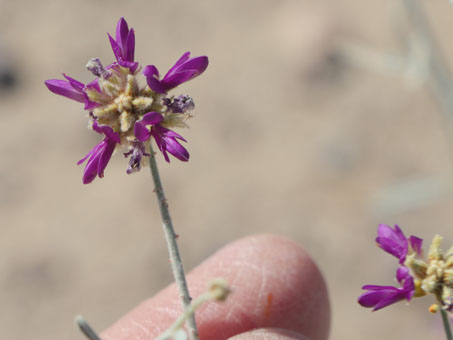
The small rounded inflorescences of Emory Dye Bush measure c. 1-1.5 cm D with individual flowers being 4-8 mm L. Color varies from light to dark purple or violet.
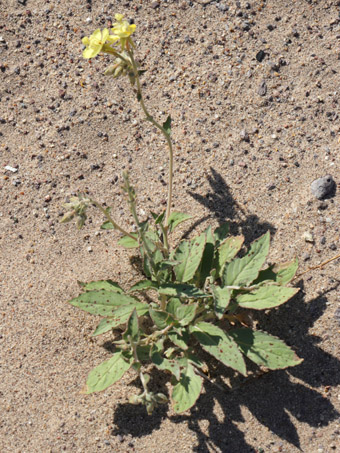
Yuma Suncup (Chylismia claviformis var. yumae, Onagraceae). This subspecies is known on the peninsula only from around this area and northward along the upper Gulf but is more common in AZ and CA in sandy dunes, desert flats, and creosote scrub.
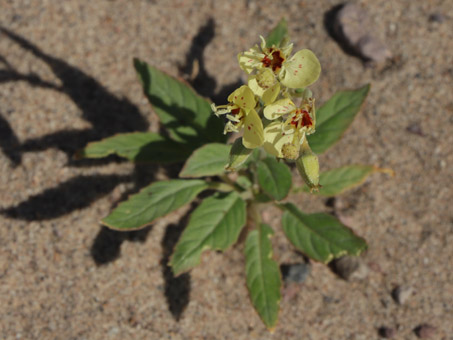
Yuma Suncup (Chylismia claviformis var. yumae). This plant stands under 30 cm H. Petals 4-5.5 mm L. The maroon in the center is the throat of the hypanthium (of the inferior ovary). Leaves are gen. densely strigose. The many-flowered inflorescence is usually nodding. The stigma is globose and there are 8 stamens.
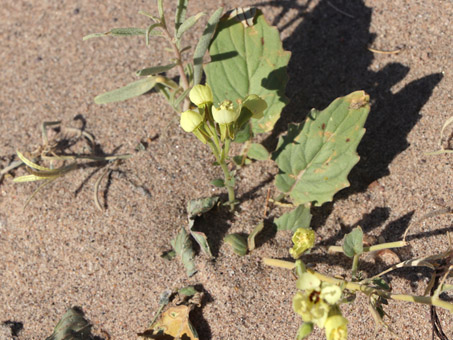
Yuma Suncup (Chylismia claviformis var. yumae). It's hard to see that the the leaves are actually pinnatifid; here the lower portions of the leaves are buried in the sand.
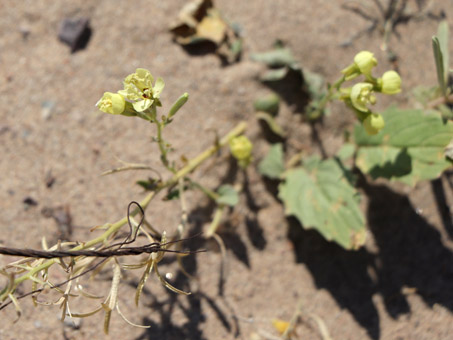
Yuma Suncup (Chylismia claviformis var. yumae). Flowers, young fruit and the spent capsule are all visible in this image. Mature fruit are 8-38 mm L and split open from the tip.
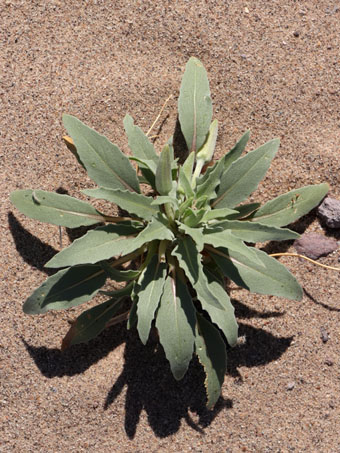
A young Dune Evening-Primrose (Oenothera deltoides var. deltoides), here c. 15 cm D. This annual can be decumbent or ascending and be 20 cm to 1 m H.
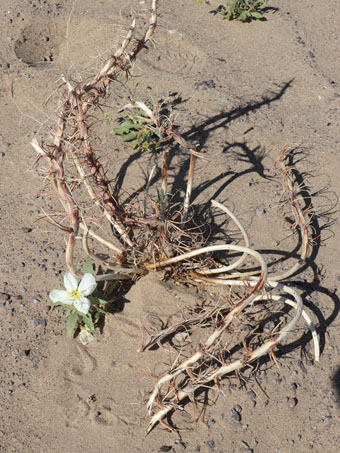
A dead specimen of Dune Evening-Primrose, also understandably known as Basket Evening-Primrose, Devil’s Lantern or
Lion-in-a-Cage. Here with a new plant growing at it's base. About 45 cm H x D.
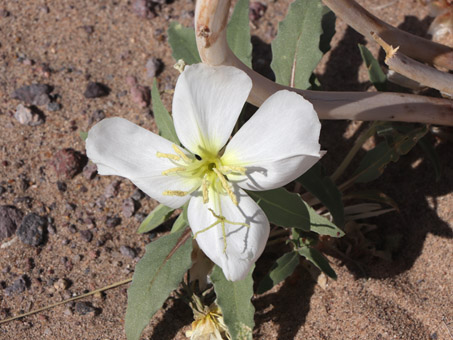
Closeup of the Desert Evening-primrose flower from the photo above right. The flowers grow in the distal axils and here, is c. 4 cm D.
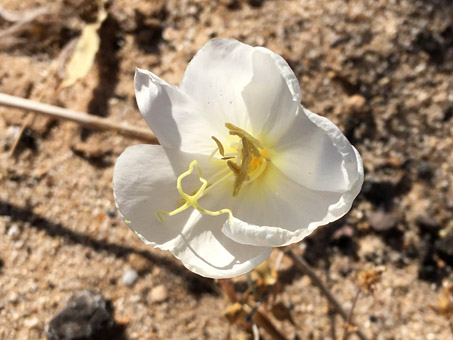
Oenothera deltoides var. deltoides flower. Note the 4-parted stigma as compared with Chylismia's globose one. It also has 8 stamens.
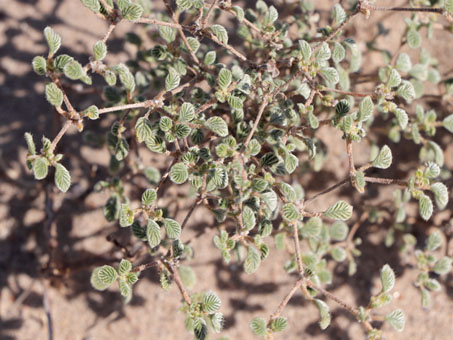
Fan-Leaf Crinklemat (Tiquilia plicata, Ehretiaceae). Another new-to-me species. This perennial herb has somewhat glandular, oppositely branching stems & obovate leaves with 4-7 pairs of deeply impressed veins. No flowers seen, but they 4-6 mm D & blue to lavender.
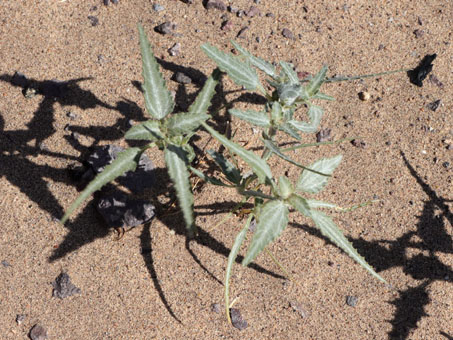
Even without flowers, from the beginning I knew this had to be some species in Asteraceae. A search on Bajaflora.org turned up a list of potential species for the location. Further research on Calflora[1] confirmed my suspicion: a young Desert Twinbugs (Dicoria canescens).
Hwy 86 - Near Mecca, CA — April 2021
Mecca is 16 miles south of Indio on Hwy 86 and near the northwestern end of the Salton Sea in the Coachella Valley. We pulled off the highway in the vicinity near an irrigation ditch. I didn't expect to find anything interesting as we stretched our legs, but besides the Giant Reed (Arundo donax, Poaceae) and Cattails (Typha sp.), I also found a couple of other species, two new to me and one an old familar from BC.
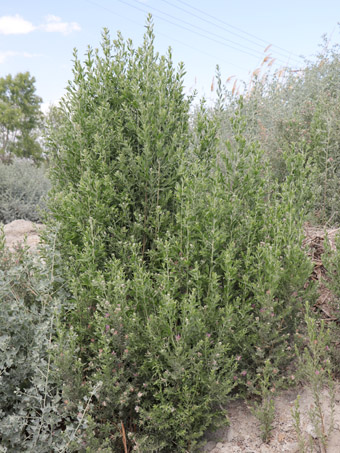
Arrow Weed / Cachanilla (Pluchea sericea, Asteraceae). There was a thicket of these large shrubs, each about 1.5-2 m H. The herbage is covered in fine silky hair.
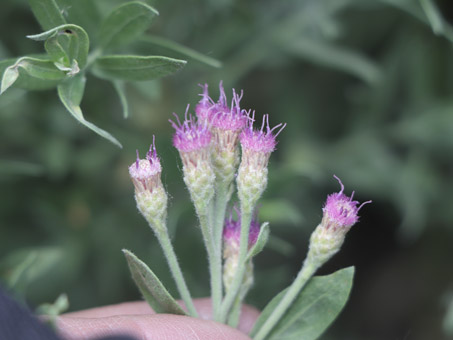
Leaves & flowers of Arrow Weed (Pluchea sericea). Involucres: 3.5-6 mm L x 3-5 mm D; disk florets rose to dark pink, 5-6 mm L. Lacking ray florets. New-to-me species.
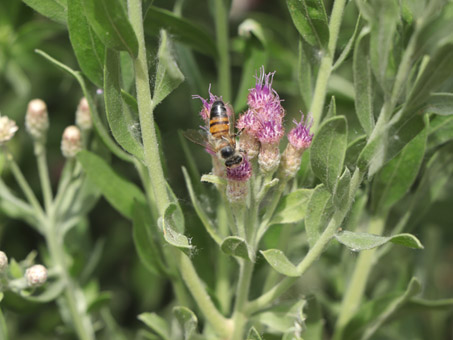
The bees certainly loved the Arrow Weed (Pluchea sericea).
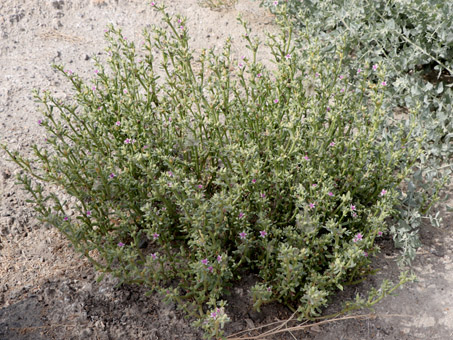
Western Sea-Purslane / Cencilla (Sesuvium verrucosum, Aizoaceae). This is an annual often with a more erect stature than S. portulacastrum (almost always spreading, prostrate to decumbent perennial).
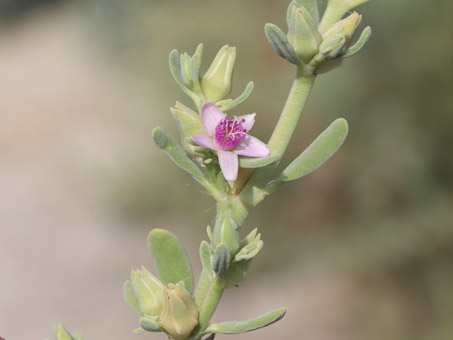
All green parts of Western Sea-Purslane are succulent. The leaves have minute, warty vesicles on their surface (verrucose = warty). I never see it mentioned, but some of the leaves often have several deep longitudinal furrows on their inferior surface near the base; two such leaves are visible on this image. See another example.
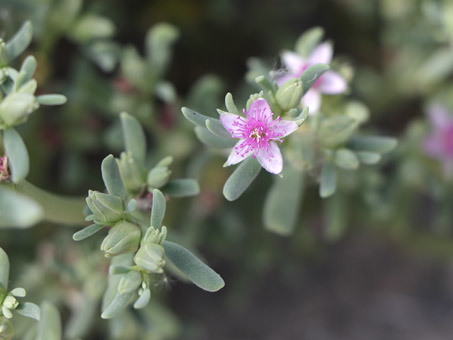
The flowers don't actually have petals, but 5 petalloid sepals 4-10 mm L, each with a green midrib on the inferior surface which extends to a point. This species seems to appear mostly inland, especially in seasonally dry or moist flats as well as along the edges of saline wetlands. Compare with S. portulacastrum.
We've come to the end of my BEE entries for at least a few months. We hope to be back in Baja California in the late Fall. Although our season this year was shorter than usual due to the pandemic, all of our forays to local spots, as well as the trips to and from Mexico, were full of lots of diverse species. We saw many more new-to-us species than expected, specifically in northern Baja California in the San Felipe Desert. So stay tuned, just in case I get an urge to share some more images and plants. Until next time, hasta pronto...
Debra Valov—Curatorial Volunteer
References
[1] Bruce G. Baldwin, adapted from Strother (2006) 2012, Dicoria canescens, in Jepson Flora Project (eds.) Jepson eFlora, https://ucjeps.berkeley.edu/eflora/eflora_display.php?tid=2448, accessed on July 08, 2021. [back to text]
Rebman, J. P., J. Gibson, and K. Rich, 2016. Annotated checklist of the vascular plants of Baja California, Mexico. Proceedings of the San Diego Society of Natural History, No. 45, 15 November 2016. San Diego Natural History Museum, San Diego, CA. Full text available online.
Rebman, J. P and Roberts, N. C. (2012). Baja California Plant Field Guide. San Diego, CA: Sunbelt Publications. Descriptions and distribution.
Turner, R. M., J.E. Bowers & T.L. Burgess (2005). Sonoran Desert Plants: An Ecological Atlas. Tucson: University of Arizona Press. Descriptions, natural history.
Valov, D. (2020). An Annotated Checklist of the Vascular Plants of Mulegé, Baja California, Mexico. Madroño 67(3), 115-160, (23 December 2020). https://doi.org/10.3120/0024-9637-67.3.115
Warren L. Wagner 2012, Chylismia claviformis subsp. yumae, in Jepson Flora Project (eds.) Jepson eFlora, https://ucjeps.berkeley.edu/eflora/eflora_display.php?tid=89253, accessed on July 07, 2021.
Warren L. Wagner 2017, Oenothera deltoides subsp. deltoides, in Jepson Flora Project (eds.) Jepson eFlora, Revision 5, https://ucjeps.berkeley.edu/eflora/eflora_display.php?tid=51747, accessed on July 07, 2021.
Wiggins, I. L. (1980). The Flora of Baja California. Stanford University Press. Keys and descriptions.














































